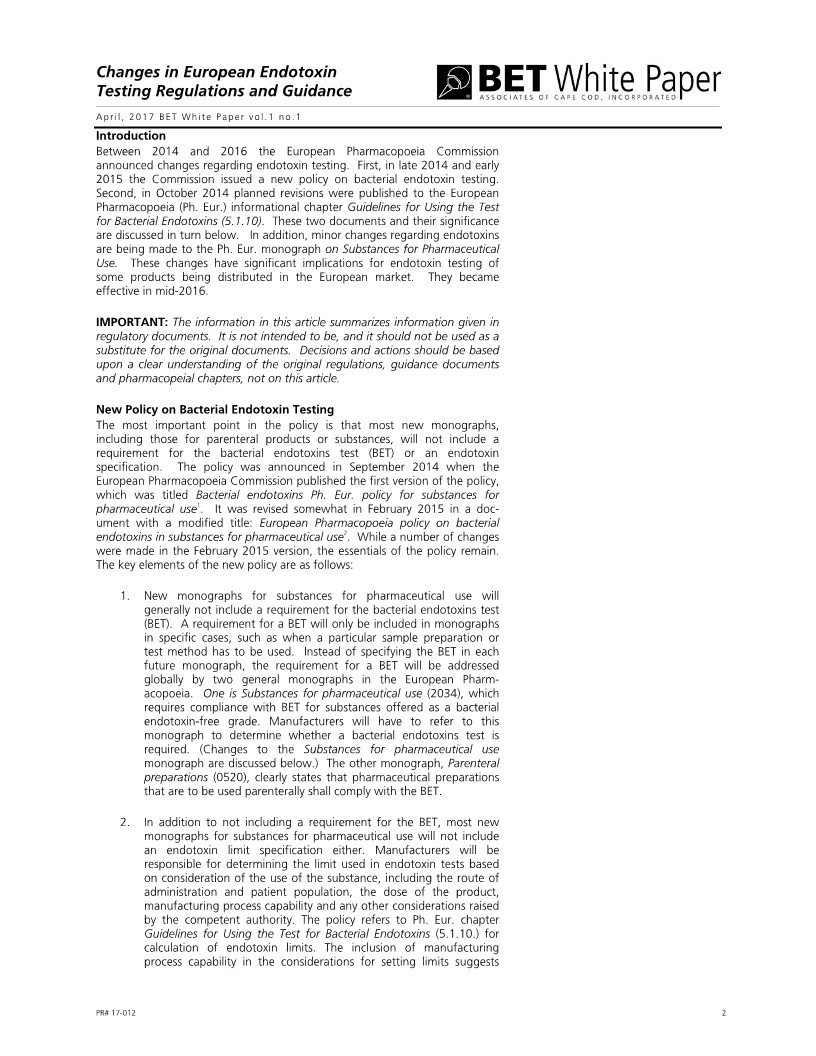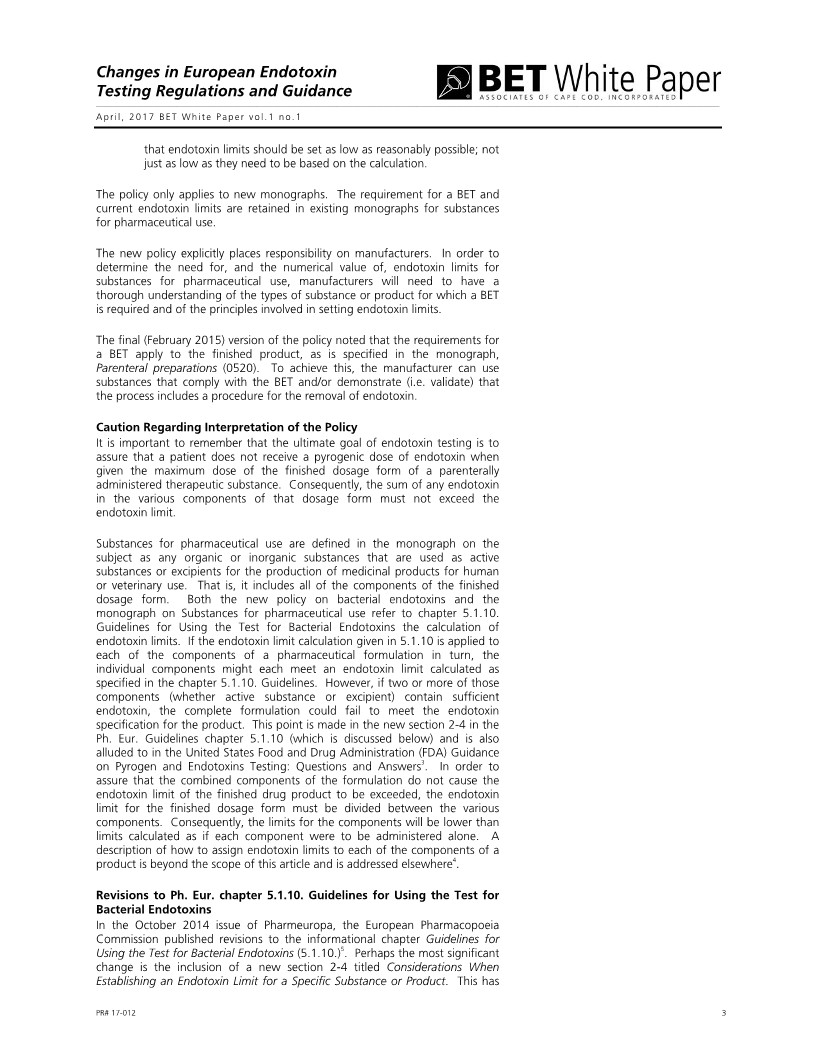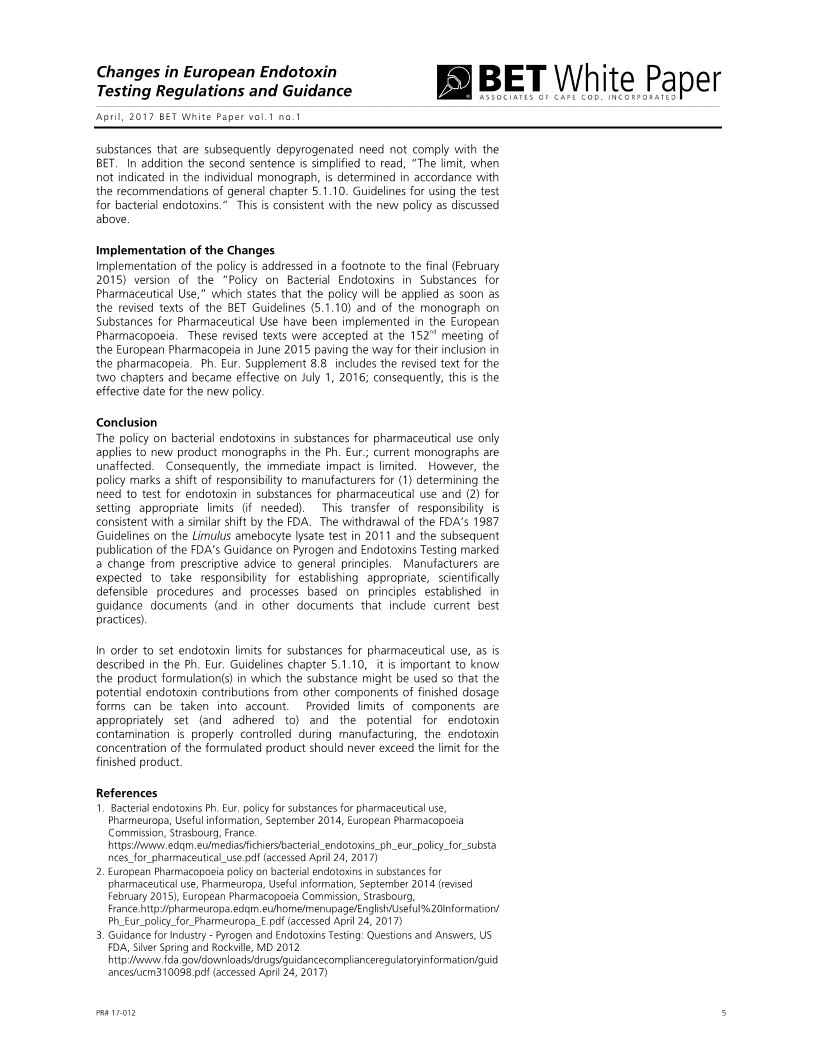欧洲内毒素检测法规和指南的第 1 项变化
- 分类:新闻资讯
- 作者:
- 来源:科德角国际
- 发布时间:2023-03-28 14:24
- 访问量:
【概要描述】Changes in European Endotoxin Testing Regulations and Guidance - By Mick Dawson
欧洲内毒素检测法规和指南的第 1 项变化
欧洲内毒素检测法规和指南的第 1 项变化
【概要描述】Changes in European Endotoxin Testing Regulations and Guidance - By Mick Dawson
欧洲内毒素检测法规和指南的第 1 项变化
- 分类:新闻资讯
- 作者:
- 来源:科德角国际
- 发布时间:2023-03-28 14:24
- 访问量:

Changes in European Endotoxin Testing Regulations and Guidance - By Mick Dawson





Changes in European Endotoxin Testing Regulations and Guidance-By Mick Dawson
Apr i l , 2017 BET W h i t e Pa per v o l . 1 no .1
Introduction
Between 2014 and 2016 the European Pharmacopoeia Commission announced changes regarding endotoxin testing. First, in late 2014 and early 2015 the Commission issued a new policy on bacterial endotoxin testing. Second, in October 2014 planned revisions were published to the European Pharmacopoeia (Ph. Eur.) informational chapter Guidelines for Using the Test for Bacterial Endotoxins (5.1.10). These two documents and their significance are discussed in turn below. In addition, minor changes regarding endotoxins are being made to the Ph. Eur. monograph on Substances for Pharmaceutical Use. These changes have significant implications for endotoxin testing of some products being distributed in the European market. They became effective in mid-2016.
IMPORTANT: The information in this article summarizes information given in regulatory documents. It is not intended to be, and it should not be used as a substitute for the original documents. Decisions and actions should be based upon a clear understanding of the original regulations, guidance documents and pharmacopeial chapters, not on this article.
New Policy on Bacterial Endotoxin Testing
The most important point in the policy is that most new monographs, including those for parenteral products or substances, will not include a requirement for the bacterial endotoxins test (BET) or an endotoxin specification. The policy was announced in September 2014 when the European Pharmacopoeia Commission published the first version of the policy, which was titled Bacterial endotoxins Ph. Eur. policy for substances for pharmaceutical use1. It was revised somewhat in February 2015 in a doc- ument with a modified title: European Pharmacopoeia policy on bacterial endotoxins in substances for pharmaceutical use2. While a number of changes were made in the February 2015 version, the essentials of the policy remain. The key elements of the new policy are as follows:
New monographs for substances for pharmaceutical use will generally not include a requirement for the bacterial endotoxins test (BET). A requirement for a BET will only be included in monographs in specific cases, such as when a particular sample preparation or test method has to be used. Instead of specifying the BET in each future monograph, the requirement for a BET will be addressed globally by two general monographs in the European Pharm- acopoeia. One is Substances for pharmaceutical use (2034), which requires compliance with BET for substances offered as a bacterial endotoxin-free grade. Manufacturers will have to refer to this monograph to determine whether a bacterial endotoxins test is required. (Changes to the Substances for pharmaceutical use monograph are discussed below.) The other monograph, Parenteral preparations (0520), clearly states that pharmaceutical preparations that are to be used parenterally shall comply with the BET.
In addition to not including a requirement for the BET, most new monographs for substances for pharmaceutical use will not include an endotoxin limit specification either. Manufacturers will be responsible for determining the limit used in endotoxin tests based on consideration of the use of the substance, including the route of administration and patient population, the dose of the product, manufacturing process capability and any other considerations raised by the competent authority. The policy refers to Ph. Eur. chapter Guidelines for Using the Test for Bacterial Endotoxins (5.1.10.) for calculation of endotoxin limits. The inclusion of manufacturing process capability in the considerations for setting limits suggests
Apr i l , 2017 BET W h i t e Pa per v o l . 1 no .1
that endotoxin limits should be set as low as reasonably possible; not just as low as they need to be based on the calculation.
The policy only applies to new monographs. The requirement for a BET and current endotoxin limits are retained in existing monographs for substances for pharmaceutical use.
The new policy explicitly places responsibility on manufacturers. In order to determine the need for, and the numerical value of, endotoxin limits for substances for pharmaceutical use, manufacturers will need to have a thorough understanding of the types of substance or product for which a BET is required and of the principles involved in setting endotoxin limits.
The final (February 2015) version of the policy noted that the requirements for a BET apply to the finished product, as is specified in the monograph, Parenteral preparations (0520). To achieve this, the manufacturer can use substances that comply with the BET and/or demonstrate (i.e. validate) that the process includes a procedure for the removal of endotoxin.
Caution Regarding Interpretation of the Policy
It is important to remember that the ultimate goal of endotoxin testing is to assure that a patient does not receive a pyrogenic dose of endotoxin when given the maximum dose of the finished dosage form of a parenterally administered therapeutic substance. Consequently, the sum of any endotoxin in the various components of that dosage form must not exceed the endotoxin limit.
Substances for pharmaceutical use are defined in the monograph on the subject as any organic or inorganic substances that are used as active substances or excipients for the production of medicinal products for human or veterinary use. That is, it includes all of the components of the finished dosage form. Both the new policy on bacterial endotoxins and the monograph on Substances for pharmaceutical use refer to chapter 5.1.10. Guidelines for Using the Test for Bacterial Endotoxins the calculation of endotoxin limits. If the endotoxin limit calculation given in 5.1.10 is applied to each of the components of a pharmaceutical formulation in turn, the individual components might each meet an endotoxin limit calculated as specified in the chapter 5.1.10. Guidelines. However, if two or more of those components (whether active substance or excipient) contain sufficient endotoxin, the complete formulation could fail to meet the endotoxin specification for the product. This point is made in the new section 2-4 in the Ph. Eur. Guidelines chapter 5.1.10 (which is discussed below) and is also alluded to in the United States Food and Drug Administration (FDA) Guidance on Pyrogen and Endotoxins Testing: Questions and Answers3. In order to assure that the combined components of the formulation do not cause the endotoxin limit of the finished drug product to be exceeded, the endotoxin limit for the finished dosage form must be divided between the various components. Consequently, the limits for the components will be lower than limits calculated as if each component were to be administered alone. A description of how to assign endotoxin limits to each of the components of a product is beyond the scope of this article and is addressed elsewhere4.
Revisions to Ph. Eur. chapter 5.1.10. Guidelines for Using the Test for Bacterial Endotoxins
In the October 2014 issue of Pharmeuropa, the European Pharmacopoeia Commission published revisions to the informational chapter Guidelines for Using the Test for Bacterial Endotoxins (5.1.10.)5. Perhaps the most significant change is the inclusion of a new section 2-4 titled Considerations When Establishing an Endotoxin Limit for a Specific Substance or Product. This has
Apr i l , 2017 BET W h i t e Pa per v o l . 1 no .1
been added to provide guidance in light of the new policy on endotoxin testing discussed above. The considerations are addressed under the following headings: Calculated endotoxin limit; Process capability; Additional safety requirements; and Formulation of the product. This last section addresses the potential for contributions of endotoxin by the various product components.
The revised chapter includes a new section 3 titled Risk Assessment. This section recommends consideration of a number of potential risks, including the potential for contamination by pyrogens other than endotoxin. In both this section and in the introduction to the chapter, the point is made that absence of bacterial endotoxins in a substance or product implies the absence of other pyrogens with the proviso that the presence of non-endotoxin pyrogenic substances can be ruled out. Section 3 recommends using the monocyte-activation test (MAT, Ph. Eur. chapter 2.6.30) to rule out the presence of non-endotoxin pyrogens at release or during development of the production process. Repeating the monocyte-activation test is recommended if any changes are made that could influence the quality of the product regarding pyrogenicity.
Other factors recommended for consideration in the risk assessment are: the nature of the production process; bioburden, particularly the potential presence of gram-positive bacteria and fungi as contaminants; the capability of the downstream process to remove bacterial endotoxin; safety, including the target population and the route of administration of the product; and the stability of the sample, particularly whether storage and handling of the test sample affects the ability to detect endotoxins.
Another addition to the revised chapter is a new section 12, Tests for Pyrogenicity in Individual Monographs. This states that monographs for parenteral products that may contain toxic amounts of pyrogenic substances require either a BET or a MAT. The rabbit pyrogen test is to be used when justified and authorized, and when the BET or the MAT cannot be validated.
The former section 12, Use of a Different Bacterial Endotoxin Test from that Prescribed in the Monograph has been replaced by section 13, Replacement of Methods Prescribed in Monographs. This includes sub-sections that address
(1) replacement of one pharmacopoeial method by another (which includes a statement that the MAT is primarily intended as a replacement of the rabbit pyrogen test) and (2) replacement of a pharmacopoeial method by an alternative method. The second subsection mentions the recombinant factor C test as an example of an alternative method, which must be validated as such under the provisions for replacing a pharmacopoeial test described in the General Notices section of the Ph. Eur. This does not represent a change because the provision for replacing a pharmacopoeial test with a suitable, validated alternative method has long been part of the General Notices in the Ph. Eur.
Ph. Eur. Monograph on Substances for Pharmaceutical Use
As was noted in the introduction, in concert with the publication of the new policy and the changes to the Guidelines on the BET, minor changes were made to the monograph on Substances for Pharmaceutical Use6.
Under the heading Bacterial Endotoxins (2.6.14), the first sentence now reads (new text indicated with underline), “If offered as a bacterial endotoxin-free grade or if intended for use in the manufacture of parenteral preparations or preparations for irrigation without a further appropriate procedure for the removal of bacterial endotoxins, the substance for pharmaceutical use complies with the test for bacterial endotoxins.” This change allows that
substances that are subsequently depyrogenated need not comply with the BET. In addition the second sentence is simplified to read, “The limit, when not indicated in the individual monograph, is determined in accordance with the recommendations of general chapter 5.1.10. Guidelines for using the test for bacterial endotoxins.” This is consistent with the new policy as discussed above.
Implementation of the Changes
Implementation of the policy is addressed in a footnote to the final (February 2015) version of the “Policy on Bacterial Endotoxins in Substances for Pharmaceutical Use,” which states that the policy will be applied as soon as the revised texts of the BET Guidelines (5.1.10) and of the monograph on Substances for Pharmaceutical Use have been implemented in the European Pharmacopoeia. These revised texts were accepted at the 152nd meeting of the European Pharmacopeia in June 2015 paving the way for their inclusion in the pharmacopeia. Ph. Eur. Supplement 8.8 includes the revised text for the two chapters and became effective on July 1, 2016; consequently, this is the effective date for the new policy.
Conclusion
The policy on bacterial endotoxins in substances for pharmaceutical use only applies to new product monographs in the Ph. Eur.; current monographs are unaffected. Consequently, the immediate impact is limited. However, the policy marks a shift of responsibility to manufacturers for (1) determining the need to test for endotoxin in substances for pharmaceutical use and (2) for setting appropriate limits (if needed). This transfer of responsibility is consistent with a similar shift by the FDA. The withdrawal of the FDA’s 1987 Guidelines on the Limulus amebocyte lysate test in 2011 and the subsequent publication of the FDA’s Guidance on Pyrogen and Endotoxins Testing marked a change from prescriptive advice to general principles. Manufacturers are expected to take responsibility for establishing appropriate, scientifically defensible procedures and processes based on principles established in guidance documents (and in other documents that include current best practices).
In order to set endotoxin limits for substances for pharmaceutical use, as is described in the Ph. Eur. Guidelines chapter 5.1.10, it is important to know the product formulation(s) in which the substance might be used so that the potential endotoxin contributions from other components of finished dosage forms can be taken into account. Provided limits of components are appropriately set (and adhered to) and the potential for endotoxin contamination is properly controlled during manufacturing, the endotoxin concentration of the formulated product should never exceed the limit for the finished product.
References
Bacterial endotoxins Ph. Eur. policy for substances for pharmaceutical use, Pharmeuropa, Useful information, September 2014, European Pharmacopoeia Commission, Strasbourg, France. https://www.edqm.eu/medias/fichiers/bacterial_endotoxins_ph_eur_policy_for_substa nces_for_pharmaceutical_use.pdf (accessed April 24, 2017)
European Pharmacopoeia policy on bacterial endotoxins in substances for pharmaceutical use, Pharmeuropa, Useful information, September 2014 (revised February 2015), European Pharmacopoeia Commission, Strasbourg, France.http://pharmeuropa.edqm.eu/home/menupage/English/Useful%20Information/ Ph_Eur_policy_for_Pharmeuropa_E.pdf (accessed April 24, 2017)
Guidance for Industry - Pyrogen and Endotoxins Testing: Questions and Answers, US FDA, Silver Spring and Rockville, MD 2012 http://www.fda.gov/downloads/drugs/guidancecomplianceregulatoryinformation/guid ances/ucm310098.pdf (accessed April 24, 2017)
Dawson, M. E. Assigning Endotoxin Limits to Noncompendial Articles, in “The Bacterial Endotoxins Test: A Practical Guide.” Ed. McCullough, K. 2011, PDA, Bethesda, MD and Davis Healthcare International Publishing LLC, River Grove, IL.
5.1.10. Guidelines for Using the Test for Bacterial Endotoxins, Pharmeuropa 26.04. Accessed in http://pharmeuropa.edqm.eu/PharmeuropaArchives/ April 24, 2017, European Pharmacopoeia Commission, Strasbourg, France.
Substances for Pharmaceutical Use, Pharmeuropa 27.02. Accessed in http://pharmeuropa.edqm.eu/PharmeuropaArchives/ April 24, 2017, European Pharmacopoeia Commission, Strasbourg, France.
Contents of EP Supplement 8.8 http://pharmeuropa.edqm.eu/home/menupage/English/Useful%20Information/Supple mentlist88_E.pdf (Accessed April 24, 2017)
扫二维码用手机看
产品推荐





底部联系方式信息(左)
400-687-1881
公司电话:010-87875910
公司邮箱:info@bio-life.cn
公司官网:www.acciusa.cn www.bio-life.cn
公司地址:北京市大兴区中关村科技园区大兴生物
医药产业基地华佗路50号院18幢(中国药谷CBP)

关注官方微信

关注手机网站





